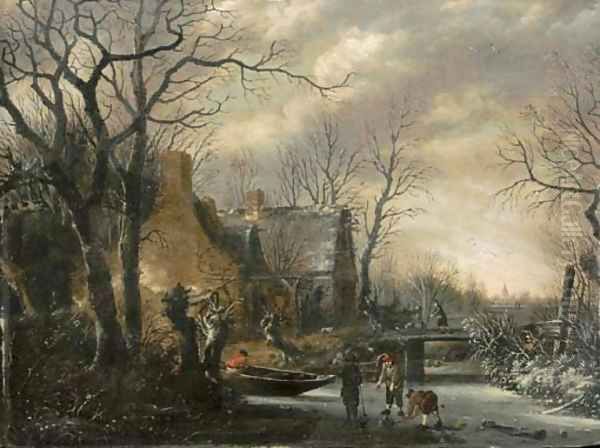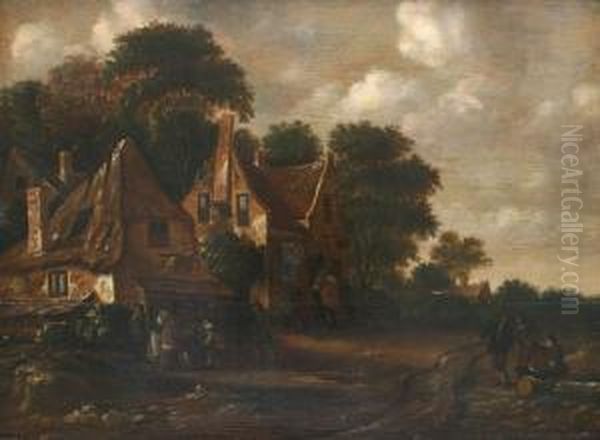Salomon Rombouts stands as a notable figure among the landscape painters of the Dutch Golden Age. Active during the latter half of the 17th century, he specialized in depicting the serene and often rustic scenery of his native Holland. Though perhaps overshadowed by some of his more famous contemporaries, Rombouts developed a distinct style characterized by careful observation and atmospheric sensitivity, contributing valuable works to the rich tradition of Dutch landscape art. His life and career, primarily centered around the artistic hub of Haarlem, reflect the typical path of many artists during this prolific period.
Born around 1652 in Haarlem, Salomon Rombouts entered a world where art, particularly landscape painting, was flourishing. He was the son of Gillis Rombouts, himself a recognized landscape painter. This familial connection undoubtedly played a crucial role in Salomon's early artistic development. It is highly probable that he received his initial training directly from his father, learning the fundamentals of composition, color, and technique within the family workshop. Such apprenticeships were common practice in the Netherlands at the time, providing young artists with practical skills and stylistic foundations.
While the exact year of his birth is sometimes cited as 1655, the consensus among art historians leans towards 1652. Regardless of the precise date, his formative years were spent immersed in the artistic environment of Haarlem, a city renowned for its landscape painters. This context provided ample inspiration and exposure to various artistic trends, shaping his future direction as an artist specializing in views of the Dutch countryside.
Artistic Career in Haarlem
Salomon Rombouts' professional career gained official recognition in 1678 when he was accepted as a master into the prestigious Guild of Saint Luke in Haarlem. Membership in the guild was a crucial step for any artist wishing to practice independently, sell their work, and take on apprentices. It signified that Rombouts had achieved a recognized level of skill and professionalism, allowing him to fully participate in the city's vibrant art market. Haarlem, during the 17th century, was a major center for painting, rivaling even Amsterdam in certain genres, especially landscape.

He primarily worked in Haarlem for a significant portion of his career, producing paintings that captured the local environment. His subjects often included wooded landscapes, village outskirts, tranquil farm scenes, and occasionally coastal or beach views, reflecting the diverse geography accessible from Haarlem. He seemed particularly drawn to the interplay of light and shadow in natural settings, often depicting scenes under cloudy skies or during the transitional light of early morning or late afternoon. His works from this period exemplify the Haarlem school's focus on realistic depictions of the native landscape.
Artistic Style and Influences
The artistic style of Salomon Rombouts is firmly rooted in the Dutch naturalistic landscape tradition of the 17th century. His works are characterized by their detailed rendering of nature, particularly trees, foliage, and atmospheric conditions. He employed a relatively subdued color palette, often dominated by earthy tones, greens, and browns, punctuated by the specific light effects he aimed to capture. His brushwork, while detailed, could also possess a certain fluidity, contributing to the overall mood of his scenes.
Undoubtedly, the most significant influence on Salomon Rombouts' style was Jacob van Ruisdael (c. 1629–1682), the preeminent Dutch landscape painter of the era, who also worked in Haarlem for a time. Rombouts adopted Ruisdael's penchant for dramatic compositions, often featuring prominent trees, cloudy skies, and a sense of nature's grandeur, albeit typically on a more intimate scale. The careful attention to texture, the rendering of light filtering through leaves, and the slightly melancholic or contemplative mood found in many Rombouts paintings echo the work of the elder master.
Another artist cited as an influence is Cornelis Decker (c. 1619–1678), a contemporary Haarlem painter known for his woodland scenes and rustic cottages, often featuring watermills. Decker's influence might be seen in Rombouts' choice of similar subjects and his handling of architectural elements within the landscape. Through these influences, combined with the foundational training likely received from his father, Gillis Rombouts (c. 1630–before 1678), Salomon forged his own recognizable, if derivative, landscape style. His work is sometimes confused with that of his father, indicating a close stylistic connection.
Key Themes and Subjects
Salomon Rombouts consistently focused on landscape themes throughout his career. His repertoire included depictions of the Dutch countryside, emphasizing its quiet beauty and the harmony between human habitation and nature. Wooded scenes were a frequent subject, allowing him to showcase his skill in rendering complex arrangements of trees, undergrowth, and dappled sunlight. Works like Forest Landscape at the Edge of a Village exemplify this interest, capturing the specific ecology and atmosphere of Dutch woodlands with considerable detail.

Rural life also features prominently in his work. Paintings such as Landscape with a Farmhouse depict idyllic, peaceful scenes of country living. These often include elements like farm buildings, peasants engaged in simple tasks, and perhaps distant church spires, all contributing to a sense of tranquil order typical of the genre. These compositions often utilize diagonal lines to lead the viewer's eye into the scene, creating a sense of depth and space.
Beyond summer landscapes, Rombouts also painted winter scenes, a popular subgenre in Dutch art. Works like Winter Landscape or Winter Scene with Skaters and Kolf Players (depicting players of 'kolf', an early Dutch game played on ice) capture the specific light and activities associated with the season. These paintings demonstrate his versatility in handling different atmospheric conditions and showcasing the social life that unfolded within the Dutch landscape, even during colder months.
The Move to Florence?
Some sources report that Salomon Rombouts moved to Italy, specifically settling in Florence, around the year 1690. This potential relocation marks a significant point of discussion in his biography. If accurate, this move would have exposed him to a vastly different artistic environment, potentially influencing his later work. The Italian landscape, artistic traditions, and light quality contrast sharply with those of the Netherlands.
However, details regarding his time in Florence are scarce and sometimes contradictory in the available records. While the move itself is mentioned, concrete evidence of his activities, commissions, or stylistic changes resulting from an Italian sojourn is not well-documented. The notion that he might have been influenced by Dutch masters like Ruisdael or Decker while in Florence seems unlikely, as their influence was established during his time in Haarlem. Furthermore, reports suggesting he studied with his father in Florence in 1690 are chronologically problematic, as Gillis Rombouts is believed to have died before 1678. Therefore, while the possibility of a move to Florence exists, its impact and details remain somewhat speculative within his overall career trajectory. He is documented as having died by 1702, though the location is not always specified.
Contemporaries and Context
Salomon Rombouts worked during a period of intense artistic activity in the Netherlands. Understanding his place requires considering the network of artists who influenced him, worked alongside him, or represented different trends. His father, Gillis Rombouts, was his primary familial connection in the art world. The dominant influence, Jacob van Ruisdael, set the standard for dramatic and naturalistic landscape painting in Haarlem and later Amsterdam. Cornelis Decker was another Haarlem contemporary whose rustic scenes bear comparison.

The broader Haarlem landscape tradition included figures like Pieter de Molijn (1595–1661), an earlier pioneer of tonal landscapes, and Jan Wijnants (c. 1632–1684), known for his dunescapes and Italianate touches. Meindert Hobbema (1638–1709), a pupil of Jacob van Ruisdael, became famous for his sunny woodland scenes, offering a slightly different mood compared to Rombouts. Although known more for figures and horses, Philips Wouwerman (1619–1668) often set his scenes in meticulously painted landscapes characteristic of the Haarlem school. Figures in Rombouts' own landscapes sometimes recall the peasant scenes of artists like Adriaen van Ostade (1610–1685).
Earlier landscape pioneers whose work formed the foundation for Rombouts' generation included Esaias van de Velde (c. 1587–1630) and Jan van Goyen (1596–1656), who were instrumental in establishing realistic Dutch landscape painting. Salomon van Ruysdael (c. 1602–1670), the uncle of Jacob van Ruisdael, was another key figure known for his river scenes and tonal subtlety. It is important to distinguish Salomon Rombouts from these artists, particularly Salomon van Ruysdael, with whom he shares a first name but not a direct familial or primary stylistic link beyond the general Haarlem school connection.
Other artists mentioned in relation to the era, though distinct in style or region, help define Rombouts' specific niche. Theodoor Rombouts (1597–1637) was a Flemish Caravaggist history painter, completely unrelated to Salomon Rombouts. Cornelis van Poelenburch (1594–1667) specialized in small-scale Italianate landscapes with mythological or biblical figures, a different genre. Mentioning giants like Peter Paul Rubens (1577–1640) or Caravaggio (1571–1610) highlights the broader European Baroque context, but their dramatic history painting had little direct impact on the specific landscape style of Salomon Rombouts.
Legacy and Conclusion
Salomon Rombouts occupies a position as a skilled and productive member of the Haarlem school of landscape painting. While perhaps not an innovator on the scale of Jacob van Ruisdael, he absorbed the key stylistic lessons of his time and applied them effectively to create appealing and atmospheric depictions of the Dutch environment. His works capture the quiet charm of woodland paths, the rustic simplicity of farm life, and the specific qualities of Dutch light and weather.
His paintings are represented in various museums and private collections, allowing viewers today to appreciate his contribution to the Dutch Golden Age. He successfully navigated the competitive art market of his time, achieving master status and producing a consistent body of work. His art serves as a valuable example of the depth and breadth of talent within the Haarlem landscape tradition, reflecting a deep connection to the natural world of the Netherlands.
Salomon Rombouts' legacy lies in his competent and often sensitive renderings of his native scenery. Working within the established conventions of his time, and heavily influenced by the towering figure of Jacob van Ruisdael, he nonetheless created works that possess their own quiet merit. He remains a figure worthy of study for those interested in the nuances of 17th-century Dutch landscape painting and the rich artistic milieu of Haarlem during its golden age. His death by 1702 marked the end of a career dedicated to capturing the enduring beauty of the Dutch landscape.